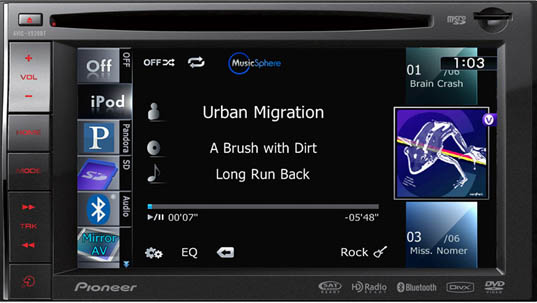Detroit auto show gives 'Pimp My Ride' a whole new meaning
"Pimp my ride" usually means decking out the car with (usually) tricky visible things like extra lights and fancy wheel covers. There was plenty of this at the North American International Auto Show at the Cobo Center, but in addition there was plenty of electronic gadgetry: navigation systems, satellite radio, voice-controlled and touch-controlled systems, and even internet connectivity.
All of these serve to help differentiate brands, but they present a number of potential distractions for the driver, and there is a good deal of evidence that even the use of a hands-free cell phone can contribute to the possibility of an accident.

Pioneer became the latest company to jump on the car-tech bandwagon this month when it unveiled a new car stereo unit - the AVIC-X920BT - that has maps with local searches, a "music sphere" and tunes from the Internet radio site Pandora.
My specialty is electronic displays and there were many of these to see. There are sound technical reasons for using flat-panel displays instead of mechanical gauges. The space behind the dashboard is crowded with wires, control levers, and ventilation ducts. Removing the mechanical speedometer, tachometer, and the like to a remote location and requiring only thin wires to the instrument panel can alleviate the congestion.
Furthermore, the electronic displays can be easily rearranged, so that a single display panel can be used in a variety of automobiles, thus saving time and money. This rearrangement can even be given to the driver to decide what readouts he wants where on the instrument panel.
Unfortunately, most of the displays were not functional; the autos did not have electrical power, so I cannot report on their performance.
Many manufacturers were showing elaborate "infotainment" systems: music, weather, navigation, internet connectivity, cell-phone operation. Some of these even respond to voice commands. The back-seat driver can now influence the operation of the vehicle. Some of these auxiliary systems are disabled while the vehicle is moving, but for some, there is just a pious notice that the device should not be used while you’re driving.
Most navigation systems were located on the dashboard above the center console, requiring the driver to look away from the road ahead. Since there is usually quite a bit of information to be digested, the potential for dangerous distraction is obvious.
Volvo had a navigation display that pops up in front of the windshield at the center of the dash, but the driver still must look away from the road. My small GPS system attaches to the windshield with a suction cup; I locate it at the left of the windshield where I can read it easily but it does not obscure a significant part of the road. I think this is a much better solution.
It was a surprise that there was only one (non-functioning) head-up display (HUD), a device that projects onto the windshield in front of the driver. This has the advantage that the driver continues to look at the road, but his vision is compromised by the symbols that are now in his field of view.
HUDs have been used for speedometer displays, for the display of night-vision cameras (this makes a great deal of sense), and for other indications. There has been very little study of the effects of these on safety.
The idea of a HUD is attractive but they have been too expensive to be widely used. They are frequently used in aircraft, but that market can tolerate much-more-expensive devices than the vehicle market. The fact that the only HUD I saw was in a Mercedes is an indication of cost problems.
There is some uniformity in the location of controls and primary instruments, a major convenience for those of us who drive more than one vehicle. There are industry standards for this.
Electronics can contribute to safety and reliability; automatic stability control and advanced braking systems are examples. However, there are some potential disadvantages. How do you get into a car with push-button door locks if the battery is dead? More importantly, this variety of auxiliary devices and controls can distract the driver, and it doesn’t take much distraction to contribute to an accident. Some limitations on excessive gadgetry is desirable.
Dr. Alan Sobel is a consulting electronics engineer and physicist specializing in electronic displays. He can be reached at as1285@columbia.edu.

